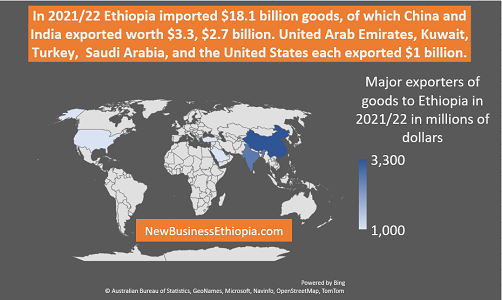Widening its trade deficit to $14 billion, Ethiopia’s import bill has surpassed 18 billion last budget year concluded July 7, 2022 with China and India supplying 33 percent of the merchandizes.
Last year Ethiopia’s import reached a historic high rising from $14.2 billion in 2020/21 to $18.1 billion in 2021-22. This has widened trade deficit of the country, which exported $4.1 last year, by $14 billion.
The growth rate of 27 percent was the highest recorded during the past decade, according to the latest analysis published by a private investment company, Cepheus Advisory. The analysis shows that for the 20th year in a row, China continues to be the leading origin for Ethiopia’s imports, providing $3.3 billion or 18% of total imports.
Other leading sources of imports are India ($2.7 billion, 15% of total) followed by UAE, Saudi Arabia, Kuwait, Turkey, and the US—all of whom each sold close to $1 billion worth of products in the Ethiopian market last fiscal year.
Three products whose global prices spiked in 2022 were among the largest imports into Ethiopia, with fuel imports reaching $3.4 billion (up 83%), cereal grain imports of $2.2 billion (up 63%), and fertilizer imports of $1.4 billion (up 98%).
These three imports are largely or exclusively imported by government agencies, and their large dollar requirements a combined $7 billion in all—have been met by forex funds from National Bank of Ethiopia / Commercial Bank of Ethiopia.
By contrast, imports largely undertaken by the private sector either declined or were broadly flat, including most notably for capital goods (-22%), vehicles (-17%) and consumer non-durables (1%).
Capital Goods
Except for imports of aircraft and heavy-duty vehicles, all sub-categories of capital goods imports fell last fiscal year, including for transport vehicles, agricultural capital equipment, and manufacturing capital equipment.
The $3 billion capital goods imports level is nearly a $1 billion drop from the year before and amounts to less than 3% of GDP versus a prior 10-year average of 7% of GDP.
Imports-to-GDP
After six years of continued decline, the import-to-GDP ratio has turned upwards last year, rising from a low of 13% of GDP to 16% of GDP in 2021-22.
“Ethiopia still remains a relatively closed economy based on this metric, however, as import-to-GDP ratios are 26% in SSA and 22% in emerging markets,” stated analysis of Cepheus.
Ethiopia as a sellers’ market
Ethiopia’s $18 billion of import purchasing power places it as a major African market for global exporters. Ethiopia stands in 6th place after South Africa, Nigeria, DRC, Ghana and Kenya as a market for foreign exporters targeting Sub-Saharan Africa.
In this context, countries that have built up market share in Ethiopia include India (+$1.5 billion extra sales in the past three years), Saudi Arabia (+$0.9 billion), UAE (+$0.7 billion), and Morocco (+$0.6 billion.)
Ethiopia’s import outlook
The Government forecasts import growth will be 10 percent this fiscal year, per the recent 2022-23 budget document. “However, even with declines in commodity prices from their exceptional highs, this growth rate very likely understates the magnitude of the import increase for the year ahead,” the analysis stated.
“An import growth rate in the mid- to high-teens seems more realistic, in our view, given still-high food import needs, large reconstruction requirements, and the limited volume adjustment being seen even in the face of elevated global prices (due to inelastic demand) for large-value imports such as fuel and fertilizers,” said the latest report of Cepheus.

